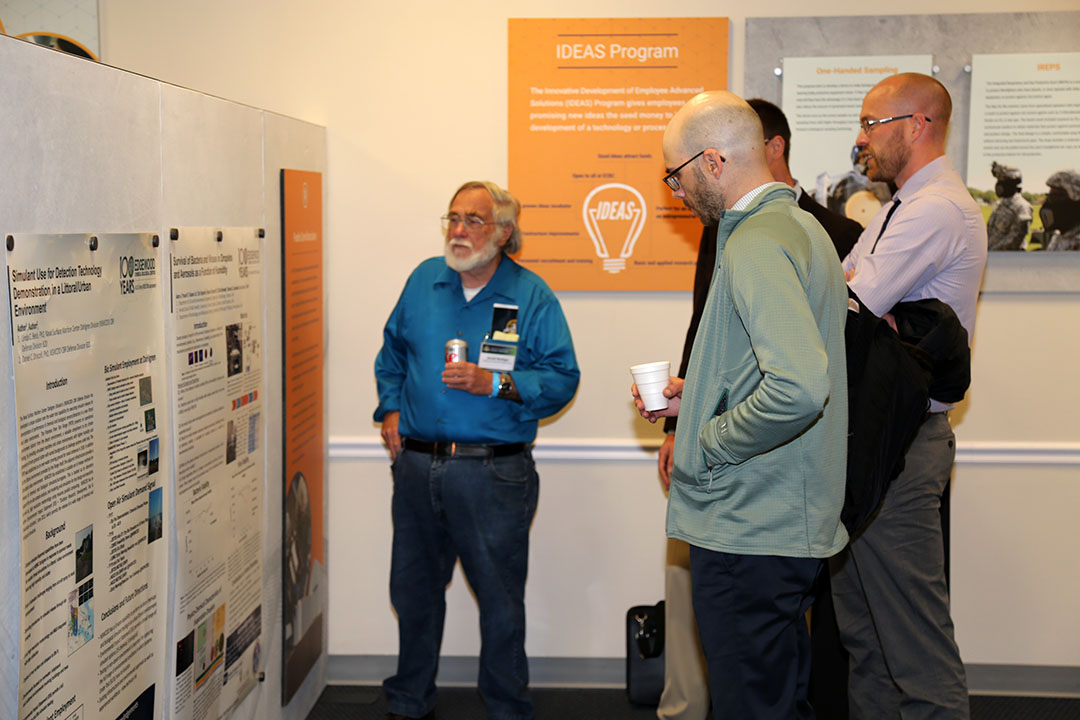// NEWS RELEASE
ECBC Hosts 3-Day Symposium for the International Aerosol Research Community
CCDC Chemical Biological Center Public Affairs | September 26th, 2017
ECBC Hosts 3-Day Symposium for the International Aerosol Research Community
DEVCOM CBC Public AffairsSeptember 26th, 2017

Scientists from defense, academic and industry laboratories around the world at a poster session during the Edgewood Chemical Biological Center’s Aerosol Symposium September 12-14.
More than 100 scientists from defense, academic and industry laboratories around the world attended the Edgewood Chemical Biological Center’s (ECBC) Aerosol Symposium from September 12 to 14 at the ECBC Conference Center in Edgewood, Md. It was the first technical conference in the aerosol defense research field to be held in eight years.
“The purpose of the symposium was to find ways for the larger aerosol research and testing community to coordinate and streamline efforts, standardize methods and techniques, and better collaborate across organizations in the face of tighter research funding,” said Aime Goad, an ECBC chemical engineer and branch chief, and leader of the team that organized the symposium. “As new challenges emerge and evolve, it’s important that not only ECBC, but the entire research community plan a strategy to meet them.”
The threat posed by aerosol delivery of chemical and biological agents was underscored by the kick-off speaker, Joseph Corriveau, Ph.D., former ECBC director and current director of the U.S. Army Cold Regions Research and Engineering Laboratory. “Aerosol dispersion is the most common way to disseminate a deadly pathogen. Models predict that an aerosol attack from an airplane in a metropolitan area would kill or incapacitate many thousands of people.” He added that their ease of production, stability as an aerosol, and ease of dispersion all make aerosol research a fundamental element of the nation’s chemical biological defense program.
The symposium returns ECBC to a tradition of bringing together the aerosol science research community. Between 1977 and 2009 when he retired, ECBC’s Aerosol Sciences Branch Chief Edward Stuebing, Ph.D., organized regular conferences. Starting 2015, Goad and fellow ECBC aerosol science researcher, Tiffany Sutton, recognized a need to revive the conferences. “We saw the aerosol threat grow evermore encompassing, and after discussing the idea with our research colleagues we decided to revive that conferences series, known back then as the Scientific Conference on Obscuration and Aerosol Research or SCOAR conference.”
Policies governing attending and hosting conferences had changed significantly since 2009, so Goad and Sutton worked with Donna Cannella, ECBC’s conference manager, to comply with current directives and requirements. Cannella enlisted support from ECBC team members to maneuver all the hurdles. In addition, then ECBC Research and Technology director, now acting director, Eric Moore, Ph.D., took a keen interest in the idea and actively encouraged them.
“We met with Donna frequently and started enlisting session chairs and presenters,” said Sutton. “All the researchers we talked to were enthusiastic about reviving the conference, and we were able to recruit session chairs and presenters from many different research institutions who would attract interest from the rest of the community.” Goad and Sutton were able to recruit speakers from a who’s who of institutions. They included the Naval Research Laboratory, MIT Lincoln Laboratory, the U.S. Army Research Laboratory, the U.S. Army Natick Soldier Research, Development and Engineering Laboratory, and the U.S. Army West Desert Testing Center, and of course, ECBC.
The presenter’s topics spanned the areas of aerosol generation and analysis techniques, sensor technologies, deposition and degradation modeling, and emerging threats. However, the history of aerosol research also proved to be a big hit. In recognition of ECBC’s 100th anniversary, U.S. Army Research, Development and Engineering Command Historian Jeffery Smart presented the history of chemical biological research at ECBC. Stuebing gave a presentation on the emergence of aerosol threat research following the Arab-Israeli conflicts to 2009. “The historical perspective really gave the attendees a sense of their special mission within chemical biological defense and the importance of their work to the nation,” said Sutton.
Goad realized that the symposium was a success by the afternoon break of the first day. “At the break, many of the attendees came up to me and told me how beneficial this is,” said Goad. “They really appreciated hearing about research in real time; the presenters discussed data they were just now collecting and had not published papers on yet.”
Attendees also appreciated the opportunity to get out of their own laboratories to network and share research ideas. “Nobody can work in a vacuum,” said Daniel Driscoll, an attendee from Naval Surface Warfare Center at Dahlgren. “You have to go outside your door or the quality of your work will suffer. The internet and teleconferences are not enough, you have to get face to face with other researchers at other labs to spitball ideas.”
Morgan Minyard, an attendee from the Defense Threat Reduction Agency agreed. “The symposium is filling a need in the research community. I got caught up on what everyone else in other agencies is doing without waiting for formal reports to be released, and I was encouraged to see the effort to standardize approaches so that sharing data will be easier. This is a good first step and needs to be continued.”
Goad and Sutton agree. “Our goal is to hold the symposium every other year with smaller special work group meetings twice a year,” said Sutton.
The U.S. Army Combat Capabilities Development Command (DEVCOM) leads in the discovery, development and delivery of technology-based capabilities to enable Soldiers to win our nation’s wars and come home safely. DEVCOM is a major subordinate command of the U.S. Army Futures Command. The DEVCOM Chemical Biological Center is the Army’s principal research and development center for chemical and biological defense technology, engineering and field operations. The DEVCOM Chemical Biological Center is headquartered at Aberdeen Proving Ground, Maryland.
